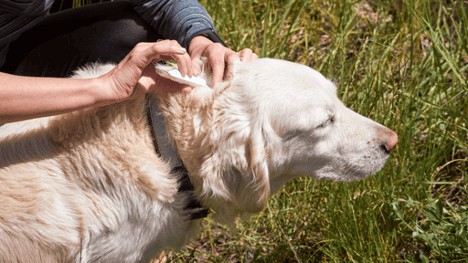Flea Treatment for Dogs [Get Rid of it Once and For All]

Watching your best friend suffer through the constant itching and agony brought on by flea infestations is a nightmare for a dog owner. Fleas annoy your dog and, if left untreated, represent serious health hazards.
You’re not the only one who has grown weary of fighting these annoying pests. Infestations with fleas are a typical issue for dog owners everywhere. This thorough guide will help you fight fleas and ensure they never come back.
Why Flea Treatment is Important for Dogs
Flea treatment is essential for your dog’s health and general well-being; it is not only an issue of convenience. Fleas are blood-feeding insects that can harm your dog’s health and are more than just a nuisance.
Fleas can cause your dog a lot of discomfort, ranging from skin rashes, itching, allergic reactions, and hair loss to more serious issues, including anemia and the spread of infections, including tapeworm, anemia, and contact dermatitis. To safeguard your pet and give them a happy, itch-free life, proactive flea prevention and routine treatment are vital.
What are Fleas?
The order Siphonaptera includes tiny, wingless insects known as fleas. Due to their flattened shape, these bloodsuckers may easily pass through an animal’s fur. To survive and procreate, they consume the blood of warm-blooded animals, such as dogs.
Effective flea control requires an understanding of the flea life cycle. There are four phases: eggs, larvae, pupae, and adult fleas. Breaking each stage of this life cycle is essential for getting rid of fleas on your dog and in their surroundings for good.
How to Spot a Dog Flea?
Early detection of a flea infestation is essential for effective treatment. Fleas can be difficult to identify because of their skill at concealment in your dog’s fur. Part your dog’s fur and look through their coat for tiny, reddish-brown or black insects running about to see if you can find them.
Flea dirt, which resembles ground pepper in appearance and consists of tiny black particles, may also be seen. You can confirm a flea infestation by combining your observations with your dog’s actions, such as increased scratching or restlessness.
The Different Types of Fleas You Can Find on Dogs
There are many other species of fleas, but Ctenocephalides felis (the cat flea) and Ctenocephalides canis (the dog flea) are the two that are most frequently found on dogs. Dog, cat, and other animal infestations are primarily caused by cat fleas. Implementing focused and efficient treatment methods will be easier with an understanding of these flea species.
Symptoms of Fleas in Dogs
Dogs with flea infestations may exhibit a variety of physical and behavioral signs. For early intervention and therapy, it is essential to recognize these symptoms.
Physical Signs of Fleas
Your dog may exhibit a number of outward signs of flea infestation, including increased scratching, irritated and red skin, hair loss, and the emergence of tiny red bumps or blisters on their skin. Flea dirt, which appears as small black specks and is flea excrement, may also be seen. It’s crucial to respond immediately if you see any of these symptoms to make your dog feel better.
Behavioral Changes in Dogs with Fleas
When dogs have flea infestations, their behavior can change as they attempt to deal with the discomfort and itching the parasites produce. Common behavioral changes that may point to a flea infestation include restlessness, irritability, increased grooming or licking, and decreased food intake. You can recognize the issue and take timely corrective action if you are aware of these behavioral changes.
Causes of Fleas in Dogs
Dogs may contract fleas from a variety of sources and situations. The key to avoiding more infestations is to understand how they get infected.
How Dogs Get Infested with Fleas
During outside activities or interactions, dogs may come into contact with stray dogs or wild animals that are infested with fleas. Even indoor dogs can get flea infestations because fleas can infest interior settings. Flea eggs and larvae can also lay latently in carpets, beds, and furniture for two to three months before hatching when the right circumstances are present.
Common Sources of Flea Infestation
Fleas can live and thrive in a variety of settings, including dog-friendly outdoor spaces, mattresses, carpets, and upholstery. They can breed in untreated or improperly cleaned locations, resulting in recurrent infestations. To avoid fleas, these places must be cleaned and treated regularly.
Diagnosing Fleas in Dogs
Effective flea treatment depends on an early and correct diagnosis. Several techniques are used by veterinarians to identify fleas in dogs.
Physical Examination for Fleas
A physical examination is the first step in determining whether a dog has fleas. The dog’s skin, coat, and flea-prone regions, including the neck, back, and tail base, are examined by veterinarians. For an accurate diagnosis, it is crucial to spot adult fleas, flea filth, or other signs of infestation during the examination.
Diagnostic Tests for Fleas
Additional diagnostic tests could be required in some circumstances to confirm the presence of fleas or eliminate other possible causes of the same symptoms. These examinations could involve combing for fleas, examining flea filth under a microscope, or performing blood tests to look for diseases linked to fleas.
Treatment Options for Fleas in Dogs
There are numerous flea treatments for dogs, each with advantages and disadvantages. Knowing your options will enable you to select the best course of action for your dog’s individual requirements.
Topical Treatments for Fleas
Popular options for flea control include topical medications, commonly referred to as spot-on medications. Usually, they are administered straight to their skin between your dog’s shoulder blades or at the base of their neck. These remedies offer enduring flea prevention and aid in infestation management.
Oral Medications for Fleas
Oral treatments are given by mouth to your dog, and they stop the flea life cycle and halt the spread of infestations. These drugs might come in the form of tasty treats or chewable tablets, making administration simple.
Flea Shampoos and Dips
When your dog is bathed with flea shampoos or dips, the fleas on their coat are killed, and the itching is relieved right away. They might not, however, provide a robust defense against upcoming infestations.
Flea Collars for Dogs
Your dog should be wearing a flea collar around their neck as a preventative precaution. They expel active flea-repelling or flea-killing chemicals. Both conventional flea collars and more recent technology-based collars that provide broader protection are available.
Home Remedies for Fleas
While some dog owners might think about adopting natural therapies to control fleas, it’s important to exercise caution because not all natural cures are reliable and secure. Before using any home cure, a veterinarian should be consulted.
Apple Cider Vinegar
Diluted apple cider vinegar is used by some dog owners as a natural flea repellant. Its effectiveness, however, can vary, and it might not offer total defense.
Baking Soda
Baking soda and salt are thought to help dehydrate and kill fleas when sprinkled on carpets and then vacuumed afterward. This approach might not be as successful as over-the-counter flea medications, though.
Coconut Oil
Coconut oil is renowned for its potential to repel insects; however, it might not be effective enough to treat fleas on its own.
Diatomaceous Earth
Use this natural ingredient to get rid of fleas on your dog’s coat and in the environment. It should be used carefully, though, because breathing in the tiny dust could be dangerous.
Garlic
Some dog owners think garlic in their dog’s diet can help them keep fleas away. Garlic eating is best avoided because it may harm a dog’s health.
Environmental Flea Control
In addition to infesting your dog, fleas can also be found in your house and surroundings. To get rid of fleas and stop re-infestation, it’s imperative to implement environmental flea management techniques.
- Regular Vacuuming: Regular vacuuming of carpets, rugs, and furniture aids in clearing the environment of flea eggs, larvae, and pupae.
- Cleaning Bedding and Toys: Regularly cleaning the bedding and accessories for your dog in hot water aids in the destruction of flea eggs and larvae.
- Treating Outdoor Areas: If your dog spends time outside, you may help the environment’s flea population by treating your yard and outdoor spaces with flea control solutions.
- Using Flea Control Products: Many flea control products are available, including powders and sprays made specifically for the environment. Other environmental control techniques can be utilized in conjunction with these goods.
What Kills Fleas Instantly on Dogs?
An insecticide called nitenpyram can quickly eliminate adult fleas in dogs. Although it offers quick relief from fleas, it does not provide long-term protection or infestation control.
How to Choose the Best Flea Treatment for Your Dog?
Flea remedies’ effectiveness in eradicating and preventing fleas depends heavily on their active ingredients. Imidacloprid, fipronil, permethrin, and pyrethroids are examples of frequently used active compounds. Popular brands that many pet owners find effective include Seresto, Simparica, and NexGard.
It will be easier for you to select the best treatment for your dog’s unique requirements if you are aware of the active ingredients present in various flea and tick remedies. Certain flea species or life stages may respond better to certain components than others.
The need for repeated applications is diminished by long-lasting flea medicines and longer flea protection. Future infestations can be avoided with options like monthly spot-on treatments or long-lasting oral drugs.
To stop the flea life cycle and keep infestations under control, flea medications must be used consistently and on time.
Easy Application: Choosing User-Friendly Treatment Options
Both the dog’s owner and the creature are in need of easy-to-use flea remedies. Ensure the treatment method you select is simple to use and carefully adhere to the specified directions.
Protecting Every Pet: Comprehensive Flea Control for Your Home
To accomplish successful flea control, if you have many pets living in the same home, you must treat each one separately. This guarantees a flea-free environment for everyone and stops the spread of fleas among dogs.
Holistic Approach: Treating Your Home and Your Dog
The area around your home should also be treated for fleas in addition to just your dog. To get rid of fleas and stop re-infestations, regularly treat and clean your home.
How to Apply Flea Meds to Your Dog
When applying any flea medication to your dog, be sure to seek the advice of your veterinarian and follow the instructions on the packaging carefully. Some general tips include reaching your pet’s skin with the applicator tip, keeping your fingers away from the dose of medication while applying, and squeezing the tube empty before you finish.
The Cost of Flea Infestation: Expenses to Consider
Flea infestations can cost money for numerous things, such as flea treatments and veterinary appointments for illnesses brought on by fleas. The most economical method to control fleas is to put preventive measures in place.
Can Pet Insurance Provide Coverage for Such an Investment?
The cost of flea treatment is one of several veterinary costs that pet insurance may cover. You might get some or all of the costs related to flea treatments refunded, depending on the kind of coverage you have for your pet.
If you’re concerned about your dog having fleas, consider these insurance plans and add-ons from Odie Pet Insurance:
The Illness & Injury Plan
Odie’s Illness & Injury Plan is designed to cover expenses associated with specific illnesses and injuries. Although it doesn’t specifically cover flea and tick treatment, you can get full coverage for your pet throughout the year, whether your dog needs emergency vet visits, 24/7 televet chats, or certain prescription medications.
The Accident-Only Plan
The Accident-Only Plan reimburses pet owners up to $10,000 yearly in expenses related to unexpected injuries. Like most other pet insurance policies, this plan does not explicitly include treatment for ticks and fleas, but Odie offers another solution to help you give your pet the complete care they deserve.
The Wellness Plan
The Wellness Plan from Odie covers routine pet care not covered by most other insurance plans. It can be purchased as an add-on, along with any Odie insurance policy of your choice, to help your dog stay healthy throughout the year. With this convenient option, pet owners can receive reimbursement for routine care items, including flea and tick prevention, to stop this concerning issue before it happens.
FAQs
Can fleas live after flea treatment?
Flea treatments aim to eliminate and prevent fleas, although some eggs or larvae may survive and later hatch. The flea life cycle can be broken, though, and the infestation can be managed with regular treatment.
How many fleas can a dog have at once?
A single female flea can produce up to 50 eggs daily, and a small number of them can quickly grow into a serious infestation. Treatment should be started very soon to prevent your dog from having a significant quantity of fleas.
How long do fleas stay on dogs?
Depending on the availability of a host and the right circumstances, adult fleas can survive on a dog for several weeks to several months.
How quickly do fleas multiply?
Fleas reproduce quickly; one flea can give birth to hundreds of progeny in a matter of weeks.
Can you remove dog fleas in a day?
You cannot get rid of fleas in a single day because successful flea treatment typically takes several processes and some time.
How frequently should I wash my dog to remove fleas?
Regular washes can help reduce the number of fleas on your dog, but a thorough flea treatment program must be followed for ultimate eradication.
Why won’t my dog’s fleas go away?
The effectiveness of several flea treatments may vary depending on how persistent the infestation is. If the infestation persists, it’s crucial to develop a complete strategy and speak with your veterinarian.
Is it hard to get rid of dog fleas?
Getting rid of fleas on a dog might be difficult, especially if the infestation is serious. For fleas to be effectively removed, treatment must be persistent and focused.
Are fleas killing my dog?
Although fleas by themselves rarely cause death in dogs, they can nevertheless cause discomfort and health problems. However, severe flea infestations might result in anemia or spread infections that could be harmful to your dog’s health.
How serious are dog fleas?
Dogs who have been bitten by fleas may experience itchiness, irritation, allergic reactions, discomfort, and agitation.
Should I touch a dog with fleas?
Even though touching a dog with fleas is safe, handling them properly is important to prevent transmitting the parasite to other people, pets, or even other dogs.
Do fleas prefer hairy dogs?
No matter how much hair a dog has on its coat, fleas will still bite. Dogs with both short and long hair can become infected.
Should I cut my dog’s hair if he has fleas?
The quantity of fleas on your dog’s coat may be decreased by trimming its hair, but this is not a replacement for effective flea treatment.
Do fleas like dark or light?
Dark or pale colors are neither preferred nor disfavored by fleas. They are drawn to warm-blooded hosts like dogs.



